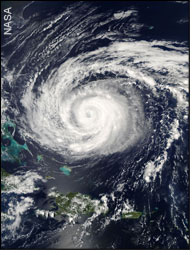![[Chesapeake Quarterly masthead]](/images/uploads/siteimages/imported/masthead.gif)
![[Chesapeake Quarterly masthead]](/images/uploads/siteimages/imported/masthead.gif) |
|
2004
|
Volume 3, Number 4
|
Table of Contents
|
Subscribe
|
Download pdf
|
ET CETERARusello Receives 2005 Knauss Fellowship
Kristin Rusello, a Marine-Estuarine-Environmental Sciences (MEES) graduate student at UMCP, has received a Knauss Marine Policy Fellowship for 2005. Named after former NOAA administrator John A. Knauss, the Sea Grant fellowship program was established in 1979 to match highly qualified graduate students with hosts in the legislative and executive branches of government or with associations and institutions located in or near Washington, D.C. Rusello is spending her fellowship year in NOAA's National Ocean Service (NOS) in the Office of Response and Restoration under the supervision of the Chief of the Damage Assessment Center, Pat Montanio. Her work will focus on implementing the Estuary Restoration Act and updating and refining the National Estuaries Database. She will also serve as a contact and support person for NOS involvement in the NOAA Habitat Program, which coordinates habitat restoration and protection efforts across NOAA. Rusello graduated with her B.S. in Natural Resources from Cornell University in 2000. Following that, she worked for two-and-a-half years as a scientist at HydroQual, Inc., an environmental engineering and consulting firm located in New Jersey. She entered the MEES program in 2002 and began work on her M.S. with Andrew H. Baldwin studying the ecology of restored freshwater tidal marshes located in Washington, D.C. Rusello is currently writing her thesis and will graduate in 2005.
One Fish Flourishes in Isabel's Aftermath
Each hurricane leaves a distinctive footprint as it blows through an area. Wind-damaged houses and flooded basements may remain the most visible signs, but large storms also have the power to encourage life as well as destroy it. Two recent studies now show that when Hurricane Isabel swept through the Chesapeake Bay region in September 2003, the storm may have created spawning conditions ideal for at least one fish species – the Atlantic croaker. After Isabel, scientists documented up to eight times the average number of baby Atlantic croaker in some parts of Chesapeake Bay. Fisheries biologists Ed Houde from University of Maryland Center for Environmental Science (UMCES) and Marcel Montane from the Virginia Institute of Marine Sciences (VIMS) independently reported similar findings at a recent conference, Hurricane Isabel in Perspective, held in mid-November as a collaborative effort spearheaded by the UMCES Integration and Application Network. The croaker-hurricane connection is not unique to Isabel, Montane found. He compiled data on storms and fish abundance over the period from 1956-2003. On average, there were three times as many croaker in hurricane as in non-hurricane years. Prior to Isabel, hurricanes Bonnie (1998), Fran (1996), Hugo (1989), Gloria and Juan (1985), and Camille (1969) had notable spikes in croaker numbers. But a one-month boom in baby croakers does not necessarily mean croaker abundance in the Bay will stay high throughout a given year, says Houde. Houde found that by April 2004, the number of 5-6 month old croaker registered as fairly average, suggesting that the large pulse of juvenile fish did not survive the winter. "Croaker are at the northernmost fringe of their range in the Bay," says Houde, "and they are sensitive to cold temperatures." Houde and Montane hypothesize that high winds during Hurricane Isabel brought a surge of upwelling, which transports nutrient-rich waters to the surface. Croakers normally spawn on the ocean's continental shelf in the fall, and the sudden increase in available food may have precipitated a large reproductive event. High winds during the storm may also have helped to push eggs and larvae from the ocean into the Bay, Houde says. Timing is of the essence with hurricanes. Isabel hit the Chesapeake region in the fall. For Atlantic croaker, whose reproductive window spans a few short autumn months, Isabel proved an impetus to reproduction. Had Isabel hit in early summer, like its infamous predecessor Agnes (1972), Montane suspects there would have been no positive effect on croaker reproduction. Moreover, an early summer hurricane like Agnes can be especially devastating, since many species of fish and shellfish – unlike croaker – spawn in spring, when heavy runoff can wreak havoc on fish habitat. If these researchers are right, then a fall arrival could link hurricanes to croaker reproduction – though a spawning boost may prove short-lived after the inevitable onset of winter's cold. |
|
|
Top of Page |
|
|
Home |
Contents |
Other Issues |
|
|
|
||||
![[Maryland Sea Grant]](/images/uploads/siteimages/imported/h_footer_mdsg.gif) ![[NOAA]](/images/uploads/siteimages/imported/h_footer_noaa.gif) |
This page was last modified November 16, 2005 |